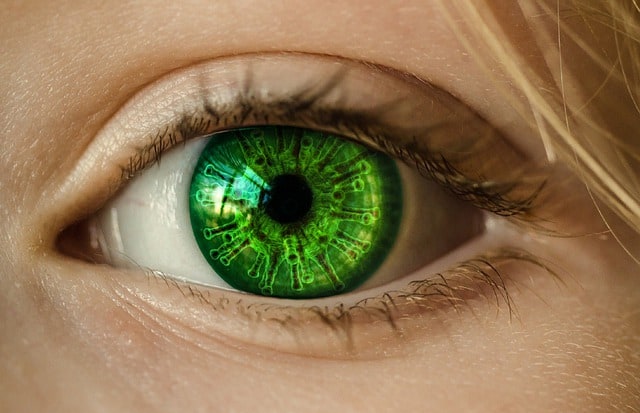
Diabetic macular edema (DME) is a complication of diabetes that can cause blindness. Macular edema is caused by retina swelling that can lead to a loss of vision or complete blindness. But new research reveals less than 50% of US adults with diabetic macular edema know their condition was caused by their diabetes.
This comes from a study published in the Journal of American Medical Association: Ophthalmology where it was also found less than 60% of diabetics have annual eye exams.
Contents
According to the National Eye Institute, Macular edema is the “build-up of fluid in the macula, an area in the center of the retina. The retina is the light-sensitive tissue at the back of the eye and the macula is the part of the retina responsible for sharp, straight-ahead vision. Fluid buildup causes the macula to swell and thicken, which distorts vision.” A DME overview includes:
- Symptoms: Blurry vision and faded or washed out color perception.
- Diagnosis: Dilated eye examinations with imaging tests of the eyes.
- Treatment: Medications (eye drops or pills), injections of anti-vascular growth factor medication, laser surgery or vitrectomy surgery in advanced cases.
Symptoms Of Diabetic Macular Edema
According to the American Academy of Ophthalmology, diabetic macular edema is often painless and usually doesn’t present noticeable symptoms in the early stages of the disease. When you do eventually experience symptoms, they are a sign that the disease has become advanced and the blood vessels in your eye may be leaking. Common symptoms include:
- Noticeable difficulty reading.
- Blurry or wavy vision and an inability to focus.
- Color vision appears faded and washed out.
If you experience diabetic macular edema symptoms you should see an ophthalmologist as soon as possible. If left untreated, diabetic macular edema can cause severe vision loss leading to blindness.

Causes Of Diabetic Macular Edema
Macular edema occurs when there is abnormal leakage of blood or bodily fluids in the macula from damaged and leaking blood vessels in the retina. There are several possible causes, including aging or injury, but the most common cause of macular edema is diabetic retinopathy, a progressive disease that occurs in people with diabetes.
When diabetes is the underlying cause, high blood sugar levels damage blood vessels, which then leak into the macula. In this set of circumstances, macular edema becomes diabetic macular edema or DME.
Diabetes And Eye Disease
Diabetic eye disease is the most common cause of vision loss in adults between the ages of 20 and 74 years old. Between the years 1990 and 2010 diabetic retinal disease was the fifth most common cause of preventable visual impairment and blindness.
As of 2010, of the 285 million people in the world diagnosed with diabetes, over a third had signs of diabetic retinal disease and one-third of them progressed on to DME. Individuals with diabetes and DME can have other complications of diabetic blood vessel loss including kidney disease, neuropathy and nervous system problems, and cardiovascular (heart) disease.
Diagnosing Diabetic Macular Edema
With early detection and treatment, the risk of severe vision loss due to DME can be reduced by as much as 90 percent! Diabetics must have regular (annual) dilated eye exams. It is vital diabetics have a dilated eye examination once a year as this could reduce their risk of severe vision loss according to the National Eye Institute.
A dilated eye exam will involve an ophthalmologist, optometrist or retina specialist putting drops into your eyes as this will allow the doctor to clearly assess all of the eye structures, including the retina, to see if there are early signs of disease or damage.
If this examination reveals there are signs of eye disease, patients will be offered several treatment options to stop the disease progressing into partial vision loss or blindness. The National Eye Institute provides the following details of the types of tests your ophthalmologist may use:
- Visual acuity test. A visual acuity test is a common way to identify vision loss and can help to diagnose vision loss as a result of macular edema. This test uses a standardized chart or card with rows of letters that decrease in size from top to bottom. Covering one eye, you will be asked to read out loud the smallest line of letters that you can see. When done, you will test the other eye.
- Dilated eye exam. A dilated eye exam is used to more thoroughly examine the retina. It gives additional information about the condition of the macula and helps detect the presence of blood vessel leakage or cysts. Drops are placed in your eyes to widen, or dilate, your pupils. Your eye care professional then examines your retina for signs of damage or disease.
- Fluorescein angiogram. If earlier tests indicate you could have macular edema, your eye care professional may perform a fluorescein angiogram. In this test, a special dye is injected into your arm and a camera takes photos of the retina as the dye travels through the blood vessels. This test helps your ophthalmologist identify the amount of damage to the macula.
- Optical coherence tomography. This is a test that uses a special light and a camera for detailed views of the cell layers inside the retina. It detects the thickness of the retina and so it’s useful in determining the amount of swelling in the macula. Your eye care professional may also use optical coherence tomography after your treatment to track how well you are healing.
- The Amsler Grid. The Amsler Grid provides an easy way to test whether or not your central vision has changed. It can recognize even small changes in your vision.
Treatment Of Diabetic Macular Edema
Treatment of DME requires correcting the underlying cause of the macular edema, thus reducing or eliminating the resulting leakage and retinal swelling. Treatment options include:
Eye Drops - As a first line approach, your ophthalmologist may prescribe non-steroidal anti-inflammatory (NSAID) eye drops for a few months and then reassess.
Laser Treatments - Using laser surgery, your ophthalmologist seals off leaking blood vessels around the macula.
Steroid Treatments - Steroids are used to treat the inflammation associated with macular edema. Steroids may be applied with eye drops, pills or injections.
Anti-VEGF Injections - New medications are available called anti-VEGF drugs, VEGF stands for "vascular endothelial growth factor." Anti-VEGF treatments help decrease leaking from blood vessels. Drops are used to numb your eye and anti-VEGF medication is injected into your eye.
Vitrectomy Surgery - Advanced macular edema may be treated with a procedure called a vitrectomy to restore the macula to its normal shape. The surgeon uses microsurgery and tiny instruments to remove the vitreous from the eye and scrape scar tissue from the macula.
Prevention Of Diabetic Macular Edema
Prevention begins with awareness. Unfortunately, many doctors fail to tell their diabetic patients about the very real risk of diabetic macular edema. If more doctors explained to their patients that DME is caused by high and unstable blood sugar, it might encourage them to work harder at lowering their blood sugar levels. Perhaps even research and seek out more natural options for diabetes management.
A February 2014 study published in the JAMA Ophthalmol found that only 44% of diabetics with DME reported being told by their doctor that their loss of vision was a result of high and unstable blood sugar, or that they even had diabetic retinopathy. And only 46% of diabetics diagnosed with DME had visited a diabetes nurse educator, dietician or nutritionist for their diabetes care.
Find professionals who can help you control your blood sugar! Find a healthcare provider who is interested in helping you control your diabetes, and not just keep you on medications for the rest of your life. A good diabetes healthcare provider should be teaching you about proper nutrition and using medication as a temporary control.
Monitor your blood glucose! Damage to the eyes of diabetics is directly related to constantly high or uncontrolled blood sugar. Keeping your glucose levels in your safe range is the best preventive measure for avoiding DME. Improve your diet, make healthy lifestyle changes and keep your blood sugar levels and HbA1c readings under control.
Stop smoking! Smoking is dangerous for any person, but doubly so for a diabetic. As a diabetic you are at greater risk of vasoconstriction and limited blood flow to your extremities and vital organs. Non-compliant diabetics often lose fingers, toes and their eyesight if they ignore their blood sugar, and smoking doubles the risk of these complications of their condition.
Action Steps To Prevent Diabetic Macular Edema
- Schedule a dilated eye examination. If you are one of the many diabetics who has not had a dilated eye exam this year, now is the time. An examination today could help you preserve your vision. An annual dilated eye examination once a year can detect vision changes and perhaps prevent eye damage. Remember, DME is relatively painless and you may not have any symptoms before they actually take place, and the damage has been done. Notify your optician or ophthalmologist that you are diabetic and ask them to examine your retina and optic nerves for any damage like leakage or swelling.
- Find a knowledgeable diabetes coach or nutritionist to help you understand how to manage your diabetes correctly. Understand that this will involve addressing diet and lifestyle factors that cause blood sugar to dramatically rise and fall.
- Live a healthy lifestyle. Make simple healthy changes to your daily routine and lower both your body weight and your blood sugar levels. Controlling your diabetes, exercising regularly, eating lots of fruit and vegetables and visiting your eye doctor at least once a year are the best steps you can take to prevent diabetic macular edema.





